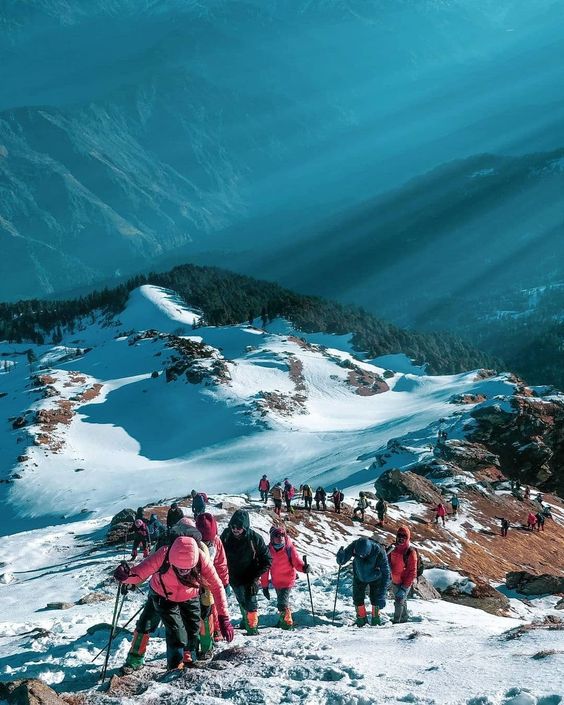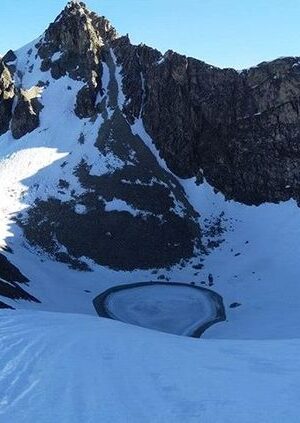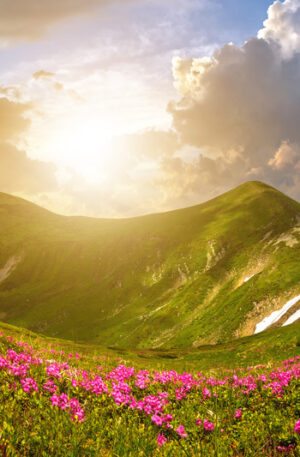PACKAGE OPTIONS
(Sankri to Sankri – 5999 + 5% Gst)
(Dehradun to Dehradun – 7499 + 5% Gst)
INTRODUCTION:
Located in the beautiful region of Uttarakhand, the Kedarkantha trek attracts traveler from all over the world to take magical walks through the area’s natural beauty and cultural marvels. Kedarkantha is a popular trekking destination in India because it provides the beauty of nature, devotional destination and thrilling activities. For several day trekkers travel through the routes that challenge them physically while presenting them with breathtaking images of the wild and during these days trekkers create unforgettable memories. Let’s begin our virtual journey to explore what’s behind the fame of the Kedarkantha trek and meaningful tips to make it a trouble-free adventure.
HISTORICAL AND CULTURAL SIGNIFICANCE:
The trekking site gets its name from the Lord Shiva Kedarkantha, and thus offers spiritual value to trekkers. It has local legends and myths that depict it as a land of gods, a blessing in the middle of a fairly long land space. During the kedarkantha trek, there are several ancient temples, prayer places, and even some age-old customs which are quite fascinating for the travelers. The dance show is integrated with the rich cultural references, from the solitary hymns of the mountains to the celebrations of the local communities.
Here we described 3 ways to reach at kedarkantha trek.
Here's a detailed guide on how to reach the Kedarkantha trek starting point:
By Air:
The best approach to the Kedarkantha trek starting point is through Jolly Grant Airport at Dehradun, Uttarakhand. Currently, you can get direct flights from various cities in India including Delhi and Mumbai among others when planning to travel to Dehradun. Once you are in Dehradun, there are various ways to get to the starting point of the trek to the Snow View Point.
By Road:
Dehradun to Sankri (Base Camp):Dehradun to Sankri (Base Camp):Though it can be reached by a bus or a shared taxi, the best option is to hire a taxi for a direct pick up from Dehradun to Sankri, which is the starting point of the Kedarkantha trek. Approximately about 8 to 9 hours of travel duration would be needed to cover the 200 kilometres distance from Dehradun to Sankri on road. Starting area gains through scenic roads which include beautiful villages and forests.
Delhi to Sankri (Base Camp):Delhi to Sankri (Base Camp):
If you are coming from Delhi, there are so many buses ply to Sankri direct If not, you have to hire a taxi to Sankri. The distance between Delhi and Sankri approximately 450 kms, and travelling hours usually 12-14 hours by road. Many private and government buses ply between the two destinations and they have both deluxe and ordinary services, both By Day and By Night.
By Train:
If you are interested in using railways here are some options: You can hire taxi or take a train from nearest railhead to Dehradun Railway Station which is well connected to almost all the major cities of India. If planning to go to Sankri, the journey starts from Dehradun, which has a rail connection, and has to be covered by road only.
The trekking distance of sankri to kedarkantha trek is of about 10 Km.
Trekking to Kedarkantha Trek Base Camp:Trekking to Kedarkantha Trek Base Camp:
After reaching Sankri, the actual trekking part starts that may take several days depending on the trekking plan. Trek to Kedarkantha base camp is moderate steep and takes around 4-5 hrs through forests and greenery which forms the meadow and lush green grass path. Depending on the plan you are to take and the package that you go for, you will be required to spend one or many days while trekking so that you can get to the base camp.
Tips for Travelers:
Trekking may be done individually or in groups, and most travelers prefer booking their transportation and accommodation ahead of time since there might be a rush during the trekking peak seasons.
Take required items like woolen wears, trekking equipment, comfortable shoes, water bottles, eatables, if any medical condition requires special medications.
Always, it is recommended to carry a map or even a GPS device, and it is also important to keep abreast with the weather and other trail news.
As part of cultures and beliefs, respect the people’s customs and traditions, and as for nature trekking, consider the best practices of eco-tourism.
By planning the journey ahead in this way, one can launch a fascinating journey to the beginning of the Kedarkantha trek and enjoy the scenic views of the Himalayas.
GEOGRAPHICAL OVERVIEW:
Located in the scenic Uttrakhand territory of Uttarkashi, the Kedarkantha trek is as enchanting as the land it passes through. It drifts through the charming terrains, green hills, forests, and meadows to exhibit the outstanding feature of Garhwal Himalayas region. Mountains rising to a great height, snowy mountain cliffs, and waterfall: all these make a scenerio that entice the eyes, mind and soul and creates a feeling of appease among the trekkers. It is placed at an altitude of 3810 meters which means that it attracts numerous trekkers and stands out as a wonderful reward for them at the top of the mountain as with its charming views of surrounding ranges and valleys.
SEASONAL VARIATIONS AND BEST TIME TO VISIT:
It is essential to know about the kedarkantha trek best time when every season has its beauty to attract the adventurers towards this marvelous trekking trail. It is during spring when this trail really stands out given that the natural foliage mostly rhododendrons transform the mountainside into a rainbow of red, pink and white flowers. Summer is slightly warmer and this is the best time to go for trekking although the environment is surrounded by thick forests and winding streams. The summer transforms the mountains with the yellowish hues and sharp air and, in the distances, the horizon awaits. But the best time for Kedarkantha trek is during the winter season, which brings in a new charm to the area by turning the trekkers into explorers walking in the blanket of snow and those who love the snow will surely love it. During the period from December to April this trek carries a great charm as the lakes here freeze, paths under the snow and the icicles also shine like crystals. This period is considered as the ideal time to visit kedarkantha trek as the trekkers are going to get an opportunity to trek amidst snows for this trekked is situated in the vicinity of himalayas. Kedarkantha trek is one of the most beautiful and peaceful trek in the India especially during winter season when the snow falls.
Kedarkantha Trek Difficulty Level
The Kedarkantha trek is considered as a relatively moderate trek that can be attempted by beginners to the adventurous as well as professionals. The highest point in the trek is left unexplored at a height of approximately 12,500 feet at Kedarkantha. Though they are not very high you actually have to change them. Able, during the Kedarkantha Trek there might be height related problems, which can be encountered most especially by those who have never been on treks with such heights.
This makes up the Kedarkantha trek which uses slow rises, steep climbs, and drops. To reach the Kedarkantha Pinnacle one has to pass through woods and hills and snowy areas of the region. The Kedarkantha trek is normally completed in winter when the cold weather engulfs the trek and the conditions. Winter can be challenging even at the Kedarkantha Headquarters, especially in the evening when the temperature can significantly drop. The overall trekking encounter can be genuinely enhanced by wellbeing preparing, and appropriate gear.
TREKKING ROUTE AND ITINERARY:
The Kedarkantha trek tour is designed to last for 5 to 6 days with over 17 to 20 kilometers of trekking across the arduous and stunning terrains. The trek begins at Sankri, a native abode that lies in the lap of Himalayas encircled by dense forests a number of hills. After reaching Sankri, the trekkers start their journey, which is an easy one initially and goes through thick forest of pine and oak and goes on ascending gradually up the heights. It crosses through scenic villages, by shatteringly photogenic rows of wooden houses and grain terraces, shedding an Timeless vision of life in the Himalayan terai. Trekking further up, trekkers get to experience alpine meadows with various wildflowers decorating the trekking ground as the vegetation type on this trekking location. Overnight stays are in tents to feel the touch of the star blankets; the camping spots are as beautiful as Juda-ka-Talab or the Kedarkantha peak base. The third and last part of an expedition pans the climbers’ reaching the top, or the so-called summit push, which is a thrilling climb up to Kedarkantha trek. At the end of the trekking activities; hikers are privileged to watch at the top a sight of mountainous snow cover, green terrains, and other distant mountains touches the roof of the horizon. In this part of the trekking, having tasted this victory trekkers go back to Sankri by covering the same trail and letting go off the majestic Himalayas behind them.
FLORA AND FAUNA:
The Kedarkantha region offers very attractive and has plenty of opportunities to explore bio-diversity with plenty flora and fauna in and around the Kedarkantha. The start of the trek has a pristine forest opening rich with oak, pine, and deodar trees that offer a mimosa ceiling to many kinds of animals and birds. As trekkers go deeper towards the alpine zone, the lush vegetation changes into fragile meadows spotted with different species of flowers such as the blue Himalayan poppy and the lovely rhododendron. These alpine meadows are feed ground of various types of vegetation eaters like musk deer, Himalayan thar and bharal or blue sheep. The hawk-eyed bird watcher will find it particularly exciting to be able to view several types of birds including most of these incredible pheasants like the Himalayan monal, the next best birds of prey which are the lammergeier and the golden eagle among many others. There are also other carnivorous animals like Himalayan Black Bear and snow leopard, which are also found in the kedarkantha region but spotting theses animals is as difficult as finding a needle in the hay stack. When trekkers move from one point to another, they are able to enjoy several musical indiscriminate sounds of nature like birds singing, and the sound of leaves shaking as they are blown by the wind from the mountains. Every time I met the plant life and the animals, I am always aware of how small the world is in the Himalayas; and the need to conserve this magnificent natural habitat to ensure it remains unspoiled in the generations to come.
CHALLENGES AND PRECAUTIONS:
For that being said, the Kedarkantha trek is comparatively easy to moderate ones for trekkers of all experiences, however, it does pose several challenges and the trekkers need to be very careful and respect the mountains. Thus, the most obvious problem that tourists have to face walking on the trek is the height, because Kedarkantha peak reaches 12,500 feet above sea level. Hikers might start feeling the effects of narrowed airways such as headache, nausea, and fatigue at such altitudes due to the progressive acclimatization processes mostly caused by high altitude sickness. To avoid compromises on altitude illness, trekkers should ensure that they follow correct pace and summit heights taking long time intervals between ascents. It is also important in avoiding altitude sickness because those who trek should ensure they take plenty of water to reduce risk of the problem. Travelers should also note that the climate in the Himalayas is quite unpredictable, with one or the other of the known four seasons likely to kick in with inconsistency: temperature fluctuations, wind, rain etc. Clothing and shoes are important to wear for warmth and protection from the cold with additional clothing and outerwear layers in case of temperature decrease. It is also important to plan to have a basic first aid kit availed and any needed medications.
The Food We’ve Offered During the Kedarkantha Trek
We serve only Indian vegetarian and mostly what you will be having for dinner is bread, vegetables, lentils and Rice with some dessert. On your trek, it will be our honor and privilege to offer you three meals in a day – breakfast, lunch, and supper. During the night, you will also be served tea and some snacks and delicious soup before dinner. If it will be a long day of hiking, you will be provided with a compressed snack.
After carrying out a lot of research on the required nutritional requirements for the trekkers, we prepared the menu. Before preparing all the meals, we also take into account elevation gained and weather.
The feast that is served by us during the trek is perfectly balanced in terms of calories, starches, nutrients, protein, fiber, and minerals. You would like to know that each of our cooks have great culinary skills and training and have been trained extensively. In this regard, prepare to enjoy heavenly and lip-smacking dishes during your trek. To start your day with a renewed feeling, you will be served with lemon tea in the tent. Before setting out for the trek, we will serve you hot and delicious breakfast options such as upma, Aallu Prantha, Besan Chilla, Poha, Daliya, Corn drops, Maggie, tea or coffee.
If your trip will be longer one then we have also few new local fruits like apples and even some strong drinks like Frootie or Maaza. In the early evening, you will be served basic and solid lunch, while at around 04:Until 7:00 pm, you will be served tea and a light night breakfast.







Reviews
There are no reviews yet.